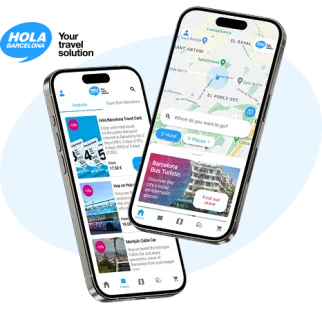Carrer de Ferran
The street connecting La Rambla and Plaça de Sant Jaume
The only straight street that connects La Rambla to Plaça de Sant Jaume is one of the Gothic Quarter’s main shopping streets. Designed in 1824 to link the main arteries of medieval Barcelona, Carrer de Ferran transformed the urban layout of the city.

Barcelona Bus Turístic, on the Hola Barcelona app
Your app for visiting the city with the Barcelona Bus Turístic: routes, stops and the most iconic places. A comfortable way to carry your tickets too!
Why visit Carrer de Ferran?
Carrer de Ferran, one of the city’s most historic streets, was designed in 1824 to link La Rambla to the citadel, but in the end it only went as far as Plaça de Sant Jaume. The architect responsible for building this straight street, which was in stark contrast to the area’s medieval winding streets, was Josep Mas i Vila, who was also behind the Neoclassical facade of Barcelona City Hall, the gate of Poblenou Cemetery and La Boqueria market.
Initially, the street was named Ferran VII, after King Ferdinand VII, who was the reigning monarch at the time, but in 1910 it was renamed Carrer de Ferran. It quickly filled with shops, mainly jeweller’s and silversmith’s shops, and became one of the city’s busiest streets. The opening of Carrer de Ferran transformed the area: the medieval church dedicated to Saint James was demolished and the new facades of City Hall and the Palau de la Generalitat now faced each other.
If you take a stroll along this street from Plaça de Sant Jaume towards La Rambla, you will see on the left the charming Carrer de l’Ensenyança and then Carrer d’Avinyó, the only one that goes all the way down to Passeig de Colom. Between Carrer d’Avinyó and Carrer d’en Rauric you will see the new church dedicated to Saint James (Sant Jaume), which preserves part of its original facade and was originally a synagogue that the area’s Jewish converts to Christianity changed into a church in 1394. Just before La Rambla is Passatge de Madoz, which leads to Plaça Reial.
How do you get to Carrer de Ferran?
On the Red Route of Barcelona Bus Turístic hop off at the Barri Gòtic stop, from where you can stroll to the end of Carrer de Ferran.
For the most curious of you
- Did you know? Carrer d’Avinyó lent its name to one of the 20th century’s most famous paintings, "The Young Ladies of Avignon" by Pablo Picasso. The work pays homage to the brothels to which this Barcelona street was home.
- Local’s tip: One hundred metres from Plaça de Sant Jaume heading towards La Rambla on the left is Passatge del Crèdit. The painter Joan Miró was born at number 4. And on another floor of the same building he had his first studio.
- A must: To discover old Barcelona.











